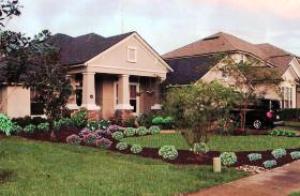|
Article
Courtesy of The St. Augustine Record By Jennifer
Edwards Published
November 14, 2011
A little-known state law has helped a local couple swap their traditional yard for one with less grass, lawn chemicals and yard work, despite neighborhood covenant restrictions.
Jennifer and John Zambrano in September asked the architectural review board at Hideaway at Old Moultrie, a small subdivision off Old Moultrie Road, for permission to install Florida-friendly landscaping, which uses low-maintenance plants and fewer chemicals than traditional lawns.
The board rejected her first request, but Jennifer Zambrano resubmitted the project and the text of a law that forces home-owners associations and municipalities to allow Florida Friendly lawns, or at least not prohibit them.
“Although many HOAs are ... encouraging home-owners to implement Florida-friendly practices, just as many choose to ignore Florida statutes and insist on green grass everywhere,” Zambrano wrote in an email. “This has resulted in homeowners being forced to enlist legal assistance and proceed with costly arbitration and mediation in order to force (associations) to abide by Florida statutes.”
Officials with the University of Florida’s Florida Friendly Landscaping Program agreed.
“There are some HOAs who are resisting due to lack of education and misconception about (it),” said Director Essen Momol. |
|
This
enhanced photograph shows what a homeowner on Garden Lake Drive wants
their landscaping to look like.
|
Had the project not been approved, Zambrano said she probably would have moved forward with arbitration.
Glen Howard, Hideaway at Old Moultrie board chair, said the holdup in approval was because the September meeting “became heated” and the couple was not willing to compromise on the design.
“The communication broke down,” Howard said.
He also said the architecture review board needed more information. Last week, the board approved the Zambranos’ request.
Zambrano said she was “relieved” and “glad the fight’s over.”
She said the next step is getting the plants in the ground.
The goals of Florida-friendly landscaping are conserving water, preserving natural resources and reducing water pollution, according to a recent University of Florida Institute of Food and Agricultural Sciences publication.
UF IFAS has a Florida-friendly landscaping program, which “promotes quality landscapes that are properly designed and maintained. Nuisance, poorly maintained, and unkempt landscapes are not considered Florida-friendly,” the publication states.
It also says associations can’t ban Florida-friendly landscape designs, but they do have control over which plants homeowners select and where they can use rain barrels or specialty gardens.
Zambrano said she worked with a local nursery to come up with the design, which features less grass and more shrubs.
Right now, there’s a bare patch of earth where there previously was lawn, and Zambrano wants to populate that area with creeping juniper, Indian Hawthorn, firebush and other shrubs.
“I’ve had a worry about chemicals in my yard for a long time,” Zambrano said.
She said she wants to change her landscaping so that she uses fewer chemicals and less water and has less yardwork to do.
Zambrano said she arrived at the idea when she realized how hard it was to maintain a full yard of St. Augustine grass.
“How ridiculous,” she remembers thinking. “This lawn doesn’t want to grow here. It’s Florida, it’s not a good place for lawns.”
She worked with a local nursery on the design and then submitted it to IFAS for approval, she said.
IFAS horticulture agent Keith Fuller wrote in a letter that the design met the Florida-friendly criteria and that it could be inspected for official certification.
If it passes, the Zambranos would get a small yard sign designating their yard as being Floridafriendly, Fuller wrote.
Florida-friendly principlesL The University of Florida IFAS identifies nine principles for Florida-friendly landscaping.
-
Right plant in the right place
-
Efficient watering
-
Appropriate fertilization
-
Mulch
-
Attraction of wildlife
-
Responsible management of yard pests
-
Recycling yard waste
-
Reduction of storm water runoff
-
Waterfront protection
Florida-friendly yard tips. There are simple and inexpensive ways to incorporate Florida-friendly landscaping practices:
-
Mow grass at the right height to encourage a deeper, more drought- and pest-resistant root system.
-
Leave grass clippings on the lawn to recycle nutrients back into the soil.
-
Direct downspouts onto turf, plant beds or containment areas where rainwater can be absorbed.
-
Establish a 10-foot-wide low-maintenance zone around any water bodies on the property.
-
Use pesticides only on affected plants or lawn areas — no indiscriminate or routine pesticide use.
-
Fertilize as needed rather than routinely.
-
Tolerate some insect damage on plants; insects are a food source for beneficial insects, birds and other organisms.
-
Make sure landscape maintenance personnel hold required pesticide certifications.
-
Prevent grass clippings, fertilizer and other debris from going into storm drains.
-
Avoid planting invasive plants in your landscape.
|
